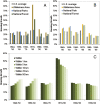Housing growth in and near United States protected areas limits their conservation value
- PMID: 20080780
- PMCID: PMC2818924
- DOI: 10.1073/pnas.0911131107
Housing growth in and near United States protected areas limits their conservation value
Abstract
Protected areas are crucial for biodiversity conservation because they provide safe havens for species threatened by land-use change and resulting habitat loss. However, protected areas are only effective when they stop habitat loss within their boundaries, and are connected via corridors to other wild areas. The effectiveness of protected areas is threatened by development; however, the extent of this threat is unknown. We compiled spatially-detailed housing growth data from 1940 to 2030, and quantified growth for each wilderness area, national park, and national forest in the conterminous United States. Our findings show that housing development in the United States may severely limit the ability of protected areas to function as a modern "Noah's Ark." Between 1940 and 2000, 28 million housing units were built within 50 km of protected areas, and 940,000 were built within national forests. Housing growth rates during the 1990s within 1 km of protected areas (20% per decade) outpaced the national average (13%). If long-term trends continue, another 17 million housing units will be built within 50 km of protected areas by 2030 (1 million within 1 km), greatly diminishing their conservation value. US protected areas are increasingly isolated, housing development in their surroundings is decreasing their effective size, and national forests are even threatened by habitat loss within their administrative boundaries. Protected areas in the United States are thus threatened similarly to those in developing countries. However, housing growth poses the main threat to protected areas in the United States whereas deforestation is the main threat in developing countries.
Conflict of interest statement
The authors declare no conflict of interest.
Figures



References
-
- Prendergast JR, Quinn RM, Lawton JH, Eversham BC, Gibbons DW. Rare species, the coincidence of diversity hotspots and conservation strategies. Nature. 1993;365:335–337.
-
- Gaston KJ, Jackson SE, Cantu-Salazar L, Cruz-Pinon G. The ecological performance of protected areas. Annu Rev Ecol Evol Syst. 2008;39:93–113.
-
- Stein BA, Scott C, Benton N. Federal lands and endangered species: The role of military and other federal lands in sustaining biodiversity. Bioscience. 2008;58:339–347.
-
- Bruner AG, Gullison RE, Rice RE, da Fonseca GAB. Effectiveness of parks in protecting tropical biodiversity. Science. 2001;291:125–128. - PubMed
Publication types
MeSH terms
LinkOut - more resources
Full Text Sources
Research Materials

